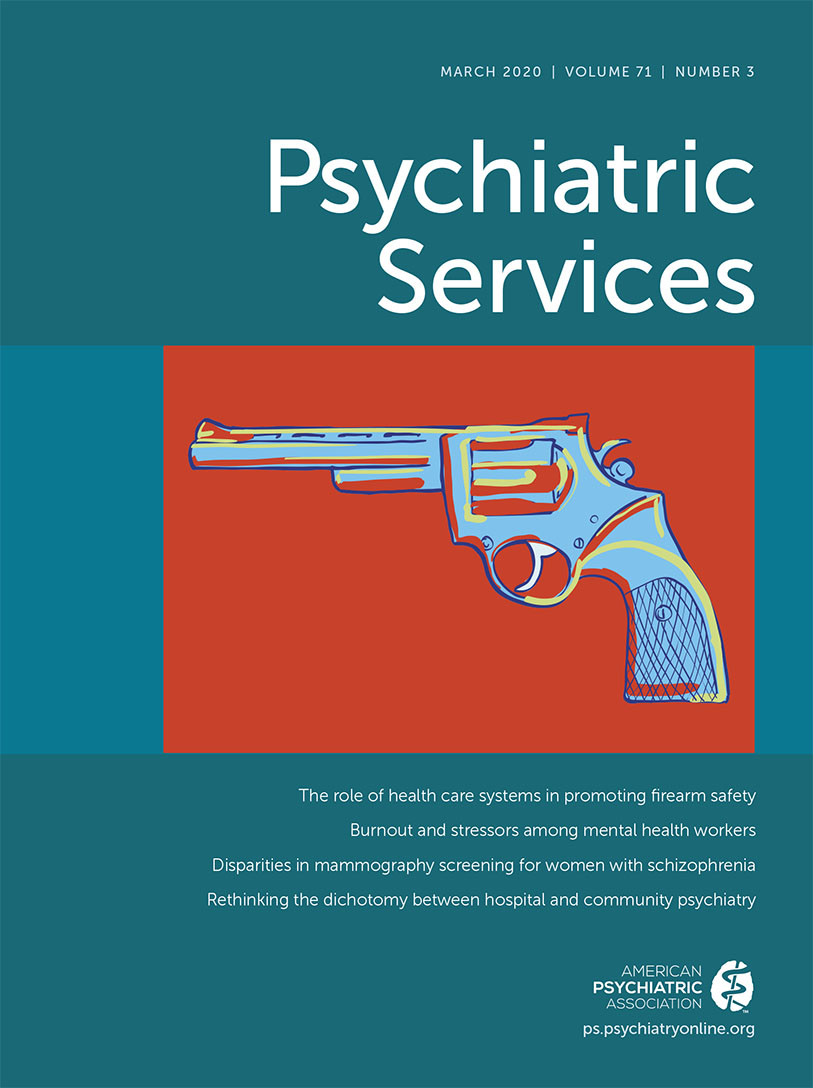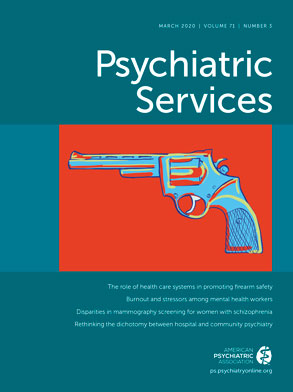Surveys indicate that 95% of U.S. adults own a mobile phone, and three-quarters own a smartphone (
1). Numerous evidence-based interventions use mobile messaging or applications (apps) to deliver services for persistent health conditions, such as smoking, obesity, or diabetes (
2). Although there is enthusiasm regarding mobile assessments and interventions for people with serious mental illness, the research and dissemination of these technologies has been slow. There continues to be substantial skepticism and uncertainty among researchers and clinicians regarding whether people with serious mental illness use mobile phones or smartphones, whether they can use the same mobile interventions as the general population, and whether it would be beneficial to tailor apps to meet the specific needs of this population (
3).
It is often difficult to implement evidence-based mental health treatments, and patients often do not use effective treatments (
4). The dissemination of mobile phones provides an opportunity for monitoring and intervention outside the clinic setting, one that enables contact with patients when and where it is convenient for them. Interventions that use mobile technology could promote health behavior change, improve the effectiveness of interventions, and reach large populations (
2). There have been studies of mobile phone ownership among people with serious mental illness (
5). Most of these studies, however, were conducted before the rapid dissemination of smartphones and contribute little information about smartphone use. Research has found that about 86% of people with schizophrenia own a mobile phone (
6). Studies have also been conducted on the feasibility of using mobile phones as part of treatment for people with serious mental illness (
7). These studies have found that mobile interventions are feasible and can improve the therapeutic alliance (
8). Attention has turned more recently to smartphone use. It is not clear how often individuals with serious mental illness use smartphones, for what functions, and whether characteristics of this population limit the use of smartphones.
Some issues specific to the population with serious mental illness may impede smartphone use. People with serious mental illness have conditions that are often accompanied by socioeconomic disadvantage, limited education, symptoms, and cognitive impairments that may affect phone use. Socioeconomic barriers to smartphone use include limited income, although the federal Lifeline program offers phones, including smartphones, to most people with serious mental illness at low cost. Cognitive barriers include pervasive problems with speed of processing, attention, working memory, verbal learning and memory, visual learning and memory, and problem solving. In-person interventions have been tailored to accommodate cognitive deficits and literacy issues (
9), but mobile interventions have not been consistently tailored for people with serious mental illness (
10).
In this study of mobile phone use among individuals with serious mental illness at two mental health clinics, we sought to understand the use of mobile phones and smartphones in this population. We examined whether and how these patients use their phones, which phone functions they use, and how phone ownership varied by demographic characteristic, education, psychiatric diagnosis, disability, and level of cognitive functioning.
Methods
Participants were recruited as part of a larger project studying interventions intended to improve the diet and activity of overweight individuals with serious mental illness (
11). Recruitment occurred at two large mental health clinics, one operated by the Department of Veterans Affairs (VA) and one by the Los Angeles County Department of Mental Health. Individuals in treatment were eligible for the study if they were overweight and had a diagnosis of schizophrenia, schizoaffective disorder, bipolar disorder, major depressive disorder with psychosis, or serious persistent posttraumatic stress disorder. The study was approved by the institutional review boards and human subjects committees of the involved institutions. Participants provided written informed consent. Enrollment occurred between March 1, 2012, and April 11, 2014. Research staff interviewed participants regarding demographic characteristics, education level, Internet access, and receipt of disability income as well as the type of mobile phone they own and which functions and apps they use on their phone. Smartphones were identified by determining the specific manufacturer and model of the phone. Patients’ cognitive functioning was measured with the Digit Symbol Substitution Test to assess neurocognitive speed of processing (
12) and the Hopkins Verbal Learning Test Revised (
13), measurements that have been associated with impairment in functioning of people with serious mental illness (
14). Cognitive functioning scores were transformed to general population norms (
12,
13). We used a multiple logistic regression to examine the effect of participant characteristics on both mobile phone use and smartphone use.
Semi-structured interviews were completed with a random subset of 48 study participants. Respondents were asked about their use of mobile phones and interest in mobile phone apps. The interviews were audio recorded and transcribed. We used Atlas.ti to organize the analyses into themes. Two research team members (N.N. and T.O.) used open coding to label text segments of interest. Transcripts were coded to the interview questions and for any additional pertinent factors emerging during coding. Discrepancies in coding were discussed by the two research team members and reconciled after coding. Overarching themes were identified from the open coding through an iterative process.
Results
A total of 326 individuals were enrolled in the larger study, including 276 at the VA clinic and 50 at the county clinic. There were 77 participants lost to follow-up who were not interviewed about mobile phone usage, leaving 249 participants for the mobile phone analyses. Mean±SD age was 54±9.8; 224 (90%) were male, 108 (43%) were white, 102 (41%) were black, 28 (13%) were Hispanic, and six (2%) were Native American. The remaining participants were of mixed or other race. There were 115 (46%) participants with schizophrenia or schizoaffective disorder, 58 (23%) with bipolar disorder, 45 (18%) with persistent posttraumatic stress disorder (PTSD), and 31 (12%) with other persistent psychotic disorders. Of the participants, 79 (32%) had a high school education or less, 159 (64%) had any college education, and 11 (4%) had any graduate school education; 138 (55%) received Social Security or VA disability payments. Participants’ mean transformed cognition score on the Hopkins Verbal Learning Test was 34.8±7.6 and score on the Digit Symbol Substitution Test was 37.4±11.5. Both these means are more than one standard deviation below population norms.
Of the participants, 213 (86%) owned a mobile phone and 149 (60%) owned a smartphone. The rates of mobile phone and smartphone ownership were similar at the VA clinic and the county clinic. Smartphones were owned by 44 (77%) people with bipolar disorder, 20 (77%) with other psychoses, 34 (76%) with PTSD, and 51 (44%) with schizophrenia or schizoaffective disorder. Of the smartphones, 105 (71%) were an Android, 40 (27%) were an iPhone, and four (3%) were a Blackberry. Of the participants with a mobile phone, 173 (81%) used it for text messaging, 127 (60%) as a camera, 111 (52%) for Internet access, 99 (45%) for e-mail, 96 (45%) for apps, 87 (41%) for music, 86 (40%) for a calendar, 61 (29%) for an alarm, and 49 (23%) for a calculator. When asked which app they used most frequently, the participants responded, in descending order of frequency, social media, videos, games, music, and maps. The second most frequently used apps were those for e-mail, social media, music, videos, games, and news.
Table 1 presents associations between participant characteristics and ownership of mobile phones and smartphones derived from our regression analyses. With the first model, we found that individuals were less likely to own any mobile phone (χ
2=33.5, p<0.001) if they were male, received disability income, or had worse neurocognitive speed of processing. With the second model, we found that individuals were less likely to own a smartphone (χ
2=52.7, p<0.001) if they were older, had schizophrenia (or other persistent psychotic disorder) rather than bipolar disorder, received disability income, or had worse neurocognitive speed of processing.
Our qualitative analyses resulted in thematic categories of facilitators, barriers, and preferences regarding mobile phones and smartphones. Facilitators of the use of mobile interventions included convenience and increased access to services. Although some respondents were hesitant about using computers, there was general enthusiasm for mobile apps. There was substantial interest in obtaining a smartphone and learning more about how to use smartphones. Participants believed that smartphones could provide them with structure, support, and services between clinic visits. Barriers to use included the costs of smartphones and data plans, concerns about privacy and security, limited experience and comfort with technology and apps, and having an old phone with limited capacity. The participant responses suggested that mobile interventions that consider issues specific to this population could be more likely to be used by people with serious mental illness and, therefore, more likely to be effective.
Discussion
The rapid increase in the rate of smartphone use has also occurred among the population with serious mental illness, with growth trends and ownership rates comparable to those of the general population. When the data in this study were collected, about 90% of U.S. adults owned a mobile phone and 55% owned a smartphone. In this sample with serious mental illness, we found similar overall rates of use. The participants used mobile phone messaging and smartphone apps frequently. This use provides an opportunity to enhance disease management by extending health interventions beyond the reach of traditional care settings. Mobile phones can be used to deliver content that is intensive, engaging, accessible, and tailored to the needs of particular patient populations. Competing demands on time (e.g., work, school, care of children and other dependents) and other barriers (e.g., transportation in urban or rural areas) can make it difficult for patients to access services during clinic hours. Mobile services can reduce the need for patients to visit mental health clinics and allow services to be brought to patients at their convenience. Although technology has revolutionized the delivery of many health care services, mental health services remain largely office based.
In other areas of health care, the introduction of patient-reported outcomes has improved treatments and outcomes and has driven measurement-based care. In mental health, there have been calls for similar interventions, as well as for apps and messaging, but questions remain regarding the use of these methods with people who have serious mental illness. Some clinicians and researchers have been concerned this population cannot use mobile phones or smartphones productively. Others believe that people with serious mental illness are able to use the same apps and interventions as populations without serious mental illness. In this study of people with serious mental illness, we found that a large proportion of the participants used mobile phones and smartphones and were interested in mobile interventions. Limitations of this study included that our sample consisted only of patients who were in treatment in one urban area, were overweight, and were willing to participate in intervention research. Therefore, the participants may not be representative of the national population with serious mental illness. Also, although Lifeline is a national program that can provide low-cost mobile phone access, people with low incomes may face other barriers to access. In this population, certain characteristics, including being determined to be disabled, having schizophrenia, or having cognitive impairment, had a meaningful impact on rates of smartphone ownership. Mobile interventions can be developed that accommodate these characteristics, and such tailoring could strengthen the impact of the interventions.
Conclusions
In this population of people with serious mental illness (i.e., schizophrenia, schizoaffective disorder, bipolar disorder, major depression with psychosis, and severe persistent PTSD), we found rates of ownership and use of smartphones that were similar to those of the general population. Opportunities exist for researchers, clinicians, and technology developers to address serious mental illness through mobile interventions delivered via smartphone. Studies of the implementation and effectiveness of mobile interventions that accommodate the cognitive, literacy, and financial characteristics of populations with serious mental illness are needed.

